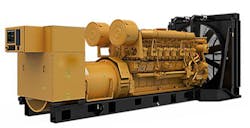Caterpillar leading Hydrogen CHP Demonstration project for Building Energy in Minnesota
Building heating and cooling utility District Energy St. Paul is contracting with engine supplier Caterpillar Inc. as part of a 2-MW combined heat and power (CHP) project fueled by a mix of hydrogen and natural gas.
The collaboration between Caterpillar and District Energy St. Paul, which provides heating and cooling to hundreds of office buildings and residences in the St. Paul region of Minnesota, will develop and demonstrate a hydrogen-fueled power delivery and control system.
The real-world application would assess every aspect of hydrogen mixes in the CHP generation. Power and heat delivered will feed into District Energy St. Paul’s distribution system.
“As a leading authority on CHP systems and the deployment of advanced energy technologies that promote sustainability, District Energy St. Paul is the ideal choice for hosting this demonstration,” said Jason Kaiser, vice president for Caterpillar’s Electric Power Division. “The project will help Caterpillar further extend our expertise in hydrogen-fueled power systems performing under the highest expectations of real-world applications.”
For the demonstration project, Caterpillar will deploy a flexible-fuel CHP system that includes the Cat Master Microgrid Controller (MMC) and a Cat G3516 generator set packaged in a standardized, factory-assembled solution to minimize complexity and infrastructure requirements.
The demonstration is supported and partially funded by the U.S. Department of Energy’s Energy Efficiency and Renewable Energy. Caterpillar is project lead with collaborators including the National Renewable Energy Laboratory.
The master microgrid controller will manage load dispatch requirements as the power system demonstrates the performance, efficiency and emissions characteristics of a hydrogen-fueled solution. Using 100% hydrogen fuel, 100% natural gas fuel, or natural gas blended with up to 25% hydrogen, the project will compare how hydrogen and hydrogen blends can be integrated into a waste-heat-and-power solution.
Ziegler, the local Cat dealer, will provide on-site support and system maintenance for the project.
Hydrogen does not emit carbon dioxide when combusted. Many power generation equipment manufacturers are experimenting with hybrid H2-gas mixes in turbines and generator-sets, including Caterpillar, Cummins, Mitsubishi Power, GE, Siemens and others.
- -- --
(Rod Walton, senior editor for EnergyTech, is a 14-year veteran of covering the energy industry both as a newspaper and trade journalist. He can be reached at [email protected]).
About the Author
Rod Walton, EnergyTech Managing Editor
Managing Editor
For EnergyTech editorial inquiries, please contact Managing Editor Rod Walton at [email protected].
Rod Walton has spent 17 years covering the energy industry as a newspaper and trade journalist. He formerly was energy writer and business editor at the Tulsa World. Later, he spent six years covering the electricity power sector for Pennwell and Clarion Events. He joined Endeavor and EnergyTech in November 2021.
Walton earned his Bachelors degree in journalism from the University of Oklahoma. His career stops include the Moore American, Bartlesville Examiner-Enterprise, Wagoner Tribune and Tulsa World.
EnergyTech is focused on the mission critical and large-scale energy users and their sustainability and resiliency goals. These include the commercial and industrial sectors, as well as the military, universities, data centers and microgrids. The C&I sectors together account for close to 30 percent of greenhouse gas emissions in the U.S.
He was named Managing Editor for Microgrid Knowledge and EnergyTech starting July 1, 2023
Many large-scale energy users such as Fortune 500 companies, and mission-critical users such as military bases, universities, healthcare facilities, public safety and data centers, shifting their energy priorities to reach net-zero carbon goals within the coming decades. These include plans for renewable energy power purchase agreements, but also on-site resiliency projects such as microgrids, combined heat and power, rooftop solar, energy storage, digitalization and building efficiency upgrades.

